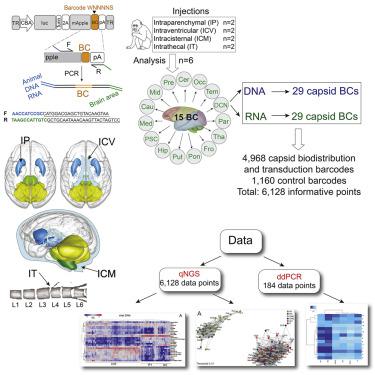Molecular Therapy ( IF 12.1 ) Pub Date : 2021-07-21 , DOI: 10.1016/j.ymthe.2021.07.010 Oleksandr Kondratov 1 , Liudmyla Kondratova 1 , Ronald J Mandel 2 , Kirsten Coleman 3 , Michael A Savage 4 , Heather L Gray-Edwards 5 , Timothy J Ness 6 , Edgar Rodriguez-Lebron 7 , Robert D Bell 8 , Joseph Rabinowitz 8 , Paul D Gamlin 4 , Sergei Zolotukhin 1

|
Non-human primates (NHPs) are a preferred animal model for optimizing adeno-associated virus (AAV)-mediated CNS gene delivery protocols before clinical trials. In spite of its inherent appeal, it is challenging to compare different serotypes, delivery routes, and disease indications in a well-powered, comprehensive, multigroup NHP experiment. Here, a multiplex barcode recombinant AAV (rAAV) vector-tracing strategy has been applied to a systemic analysis of 29 distinct, wild-type (WT), AAV natural isolates and engineered capsids in the CNS of eight macaques. The report describes distribution of each capsid in 15 areas of the macaques’ CNS after intraparenchymal (putamen) injection, or cerebrospinal fluid (CSF)-mediated administration routes (intracisternal, intrathecal, or intracerebroventricular). To trace the vector biodistribution (viral DNA) and targeted tissues transduction (viral mRNA) of each capsid in each of the analyzed CNS areas, quantitative next-generation sequencing analysis, assisted by the digital-droplet PCR technology, was used. The report describes the most efficient AAV capsid variants targeting specific CNS areas after each route of administration using the direct side-by-side comparison of WT AAV isolates and a new generation of rationally designed capsids. The newly developed bioinformatics and visualization algorithms, applicable to the comparative analysis of several mammalian brain models, have been developed and made available in the public domain.
中文翻译:

非人类灵长类中枢神经系统中 29 衣壳 AAV 文库的综合研究
非人类灵长类动物 (NHP) 是在临床试验前优化腺相关病毒 (AAV) 介导的 CNS 基因传递方案的首选动物模型。尽管它具有内在的吸引力,但在一个功能强大、全面的多组 NHP 实验中比较不同的血清型、递送途径和疾病适应症是一项挑战。在这里,多重条形码重组 AAV (rAAV) 载体追踪策略已应用于对八只猕猴 CNS 中 29 种不同的野生型 (WT)、AAV 天然分离物和工程衣壳的系统分析。该报告描述了在实质内(壳核)注射或脑脊液(CSF)介导的给药途径(脑池内、鞘内或脑室内)后,每种衣壳在猕猴 CNS 的 15 个区域的分布。为了追踪每个分析的 CNS 区域中每个衣壳的载体生物分布(病毒 DNA)和靶向组织转导(病毒 mRNA),在数字液滴 PCR 技术的辅助下,使用了定量的下一代测序分析。该报告使用 WT AAV 分离株和新一代合理设计的衣壳的直接并排比较,描述了在每种给药途径后针对特定 CNS 区域的最有效的 AAV 衣壳变体。新开发的生物信息学和可视化算法适用于几种哺乳动物大脑模型的比较分析,已经开发并在公共领域提供。采用数字微滴 PCR 技术辅助。该报告使用 WT AAV 分离株和新一代合理设计的衣壳的直接并排比较,描述了在每种给药途径后针对特定 CNS 区域的最有效的 AAV 衣壳变体。新开发的生物信息学和可视化算法适用于几种哺乳动物大脑模型的比较分析,已经开发并在公共领域提供。采用数字微滴 PCR 技术辅助。该报告使用 WT AAV 分离株和新一代合理设计的衣壳的直接并排比较,描述了在每种给药途径后针对特定 CNS 区域的最有效的 AAV 衣壳变体。新开发的生物信息学和可视化算法适用于几种哺乳动物大脑模型的比较分析,已经开发并在公共领域提供。











































 京公网安备 11010802027423号
京公网安备 11010802027423号